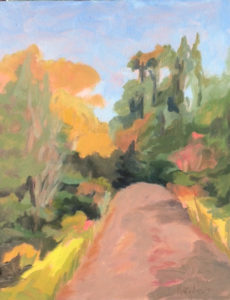 This week I went out on a trail where the leaves are turning, colors singing. The soil in this part of the state has a lot of iron in it. As a result, the dirt under my boots and all ahead of me is an unremarkable dull red-brown. The perfect foil for the brilliance decking the foliage layers on the sides of the road, I made this trail the centerpiece then. It seemed good to do. On this ground is where I stand with my easel. It’s my reference point. In the painting, I started here too, mixing the dull hues as the base line. The dirty earth is the substance out of which all this other beauty gains its nourishment, and then its contrasting show. But soon the colors above will dull too and fall back on down to the mud, enriching it with deadness and only slim memory of a day like this was. I captured a bit of it. But I often think on this idea that beauty is ultimately un-capturable in any really satisfying way. This transience, or fleeting quality seems to me to be the nature of things we call beautiful. With beauty you are ushered to a lovely impression which beckons deeply and then the knowing of it disappears as quickly as Tinkerbelle. I grasp at hues out of tubes, and mix with intention. I make stabs with the brush trying to produce a likeness. But the image is never as rich as what my retina reveled in. Beauty is a whiff of something I can’t fully own, it seems. It’s a signifier, a stand in for something grander that is calling my soul. And I keep traveling after it. I think of beauty as a moment’s glimpse of forever while my feet are still gravity bound in this mud.
This week I went out on a trail where the leaves are turning, colors singing. The soil in this part of the state has a lot of iron in it. As a result, the dirt under my boots and all ahead of me is an unremarkable dull red-brown. The perfect foil for the brilliance decking the foliage layers on the sides of the road, I made this trail the centerpiece then. It seemed good to do. On this ground is where I stand with my easel. It’s my reference point. In the painting, I started here too, mixing the dull hues as the base line. The dirty earth is the substance out of which all this other beauty gains its nourishment, and then its contrasting show. But soon the colors above will dull too and fall back on down to the mud, enriching it with deadness and only slim memory of a day like this was. I captured a bit of it. But I often think on this idea that beauty is ultimately un-capturable in any really satisfying way. This transience, or fleeting quality seems to me to be the nature of things we call beautiful. With beauty you are ushered to a lovely impression which beckons deeply and then the knowing of it disappears as quickly as Tinkerbelle. I grasp at hues out of tubes, and mix with intention. I make stabs with the brush trying to produce a likeness. But the image is never as rich as what my retina reveled in. Beauty is a whiff of something I can’t fully own, it seems. It’s a signifier, a stand in for something grander that is calling my soul. And I keep traveling after it. I think of beauty as a moment’s glimpse of forever while my feet are still gravity bound in this mud.
Category Archives: brokeness
semblance
This blog is a stream of thoughts on current evidences. Each gives hint toward what I think is much bigger reality. My tag line above says I am “illustrating”, which may be strange because as an artist, I am not a skilled illustrator. I know at this late age what I can and what I cannot do. My own artwork is usually abstract, and certainly much less focused on human form. All this is intro. to some pondering today.
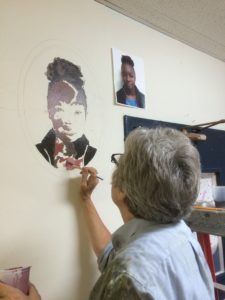 I am working on a mural for a non-profit in my community. I got to design the entire project and knew that the best idea for this refuge place for kids would be to highlight the very ones the organization serves. We took photos of 10 selected kids, then posterized them, and sketched the value divisions from each face onto the wall. Painting will start this coming week. What I hope to express here is how poignant it was to just draw their young faces, the unique smile curves, the spark in some eyes, the little crooked tooth, the sweetness on each entirely different form. These are just semblaces on a wall. But I know the real kids a little bit. I interviewed each to gain some buy-in for the ideas behind this whole project.
I am working on a mural for a non-profit in my community. I got to design the entire project and knew that the best idea for this refuge place for kids would be to highlight the very ones the organization serves. We took photos of 10 selected kids, then posterized them, and sketched the value divisions from each face onto the wall. Painting will start this coming week. What I hope to express here is how poignant it was to just draw their young faces, the unique smile curves, the spark in some eyes, the little crooked tooth, the sweetness on each entirely different form. These are just semblaces on a wall. But I know the real kids a little bit. I interviewed each to gain some buy-in for the ideas behind this whole project.
Each child represents one key value that guides this organization. To hear from the children was entirely motivating. So unique is each little person, with a complex mix of bents and desires and issues. So now, when I semblance their lines with pencil on the wall, I am thinking of each child with a love that I sense originates from their Maker. No wonder Jesus rebuked the disciples for attempting to dismiss the children. Little wonder had those guys! Like all of us, they had their own working agendas in front of their own faces and could not see what He was looking into. I am getting a glimpse.
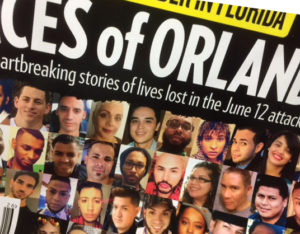 While sketching onto this wall, I was living through the news reports; faces all lined up (each completely unique) who were mowed down by a murderer’s gun in Orlando. You probably saw those images too. I did not know those folks, and so I cannot share the same sense of relationship. But the loss is incalculable for those who loved them. Such searing pain is grief! We are all robbed when even one precious soul is ripped away. Robbed and ripped and many, many left sorrowing.
While sketching onto this wall, I was living through the news reports; faces all lined up (each completely unique) who were mowed down by a murderer’s gun in Orlando. You probably saw those images too. I did not know those folks, and so I cannot share the same sense of relationship. But the loss is incalculable for those who loved them. Such searing pain is grief! We are all robbed when even one precious soul is ripped away. Robbed and ripped and many, many left sorrowing.
In a time when human life is so diminished, as anger and division takes center stage, as political agendas get staged while the blood is still warm on the floor, is anyone listening for how Jesus feels? Sketching faces of kids who hold dreams in their hearts, I was being pierced through. Anger, sadness, sighs and reverence are all mingled through these pencil lines.
I can hardly illustrate. I am tracing after a projection, my pencil follows the light. In the same way, I can hardly be coherent about what I sense are the working unseen values. But I feel Jesus’ heart, as if tracing after Him. And what I am talking about is both an engaging and a fearful thing. As an artist I am weighted with this significance.
And then I remember: this is what all art is, whether realistic illustration or abstraction, no matter the form. Whether seen and understood or not. It is all just a catch, a representation of something else. It is at best a quick and searing glimpse, a sign-post, a semblance of much truer things. What we do see right in front of us can point toward what we desperately need to see.
slice
When it is time for pie, what do you ask for? A slice is all you can manage, really. We instinctively get this. Being engorged on the whole of what is a really good thing–is not a good thing. Small doses are better handled. Our limits require bits, not wholes. The whole can overwhelm.
It is the same with the biggest ideas, the most important things. We need time with them, and time is a distinct mercy because of our very dastardly limits. Time gives us the opportunity to take it in.
Maybe this alone explains why I keep making art. It is a big thing that is too big for me. I am manipulating paint and wax, working brush and color, moving seriously through my own inner angst. I am looking for a way to feed, even as I am hungry.
And trouble is: every day there seems to be more and more to be upset about. A man I am close to, and respect a lot said to me in distress “I am angry all the time!” We both know we have to be constantly on the lookout for better slices.
As for that inner angst, I have recently been working on a long study of the Old Testament prophets, specifically gathering clues as to how they managed their emotions as things were going down. We are in that time. My anger is not a holy thing, even justified anger. I want to slice and dice the rapist. I want to slice and dice the smug and comfortable liar. I want to slice and dice those who pervert justice in their blindness to suffering. But I am not God (aren’t you glad). I sense indigestion deep in my core when I attempt His prerogative. Instead I am talking to Him, distilling with Him–and that work is a really good thing, something I want more slices of.
So, instead of slicing and dicing people (you, or me or the rapist) I will leave that to God who promises to do a good job of it. I will pass on His job.
 And I will use my energy instead to slice a section of a piece I painted Monday. I was at a beautiful farm owned by a woman named Ginger in a place called Goshen Valley. I was standing painting quietly next to a friend who also is suffering on the inside and doing it bravely. We took courage together and both managed to look out and to gather in some of the beauty and the glory with our brushes. That was a good day. The whole is good. But for now: just a slice, thank-you. I can be sustained with a good slice. For here’s a simple truth, easy to absorb: that which is good comes from Him (every last bit of it) and that which is not good does not.
And I will use my energy instead to slice a section of a piece I painted Monday. I was at a beautiful farm owned by a woman named Ginger in a place called Goshen Valley. I was standing painting quietly next to a friend who also is suffering on the inside and doing it bravely. We took courage together and both managed to look out and to gather in some of the beauty and the glory with our brushes. That was a good day. The whole is good. But for now: just a slice, thank-you. I can be sustained with a good slice. For here’s a simple truth, easy to absorb: that which is good comes from Him (every last bit of it) and that which is not good does not.
writing into the dirt
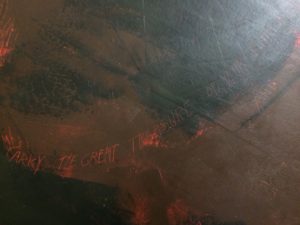 The idea (last post) of God writing has had me musing. For text marked into pieces of ground is kind of a current thing. Detailed is just a fragment of a painting I saw last week in a gallery in Asheville, NC. The hand is artist Carol Bomer’s. The marking of words gives direction not only visually but conceptually. One takes in the whole of this dark piece as it envelopes your eye-space, but then the writing captures your focus.
The idea (last post) of God writing has had me musing. For text marked into pieces of ground is kind of a current thing. Detailed is just a fragment of a painting I saw last week in a gallery in Asheville, NC. The hand is artist Carol Bomer’s. The marking of words gives direction not only visually but conceptually. One takes in the whole of this dark piece as it envelopes your eye-space, but then the writing captures your focus.
We think this marking into media is avant-garde. Search and you’ll find lots of new and inventive uses of text. But the idea is as old, really, as the hills. At the Mountain called Sinai, the finger of God etched his law into two pieces of rock. This inscribing of text was not Moses’ idea. The finished tablets were not Moses’ handiwork. The entire initiative was God’s. Moses was only the invited mediator. (There are many questions here: If God is God, why did he even need to use a finger? Why two tablets, why not 10, why not one? Why was any mediator needed? Why were words needed? Were the Hebrews, recently slaves, literate? Was the marking that God used common Egyptian?) Back to what’s clear in the story: Moses responded as he was asked. He picked up the rock slabs and brought them down from Sinai to the awaiting tribes.
Think about this even if you don’t know much more. The Hebrew text makes it plain that God’s own finger made visible markings on 2 pieces of mountain rock. He communicated, from His otherness into man’s space. This was one directional. He selected a means that was legible, tangible and understandable. Then came the history of man’s response to that specific communication.
Besides the later episode in Babylon with the mysterious hand (previous post), there is no other hint of God Himself writing in the whole of the Hebrew Bible.
Fast forward to what is called the New Testament or that part of Scripture that tells of Jesus’ arrival and the revolution he brought. There is only one recorded episode of Jesus writing. The story is found only in John’s telling of events. The context is a test. Religious lawyers drag a woman before Jesus. Having just been caught breaking one of the laws on Moses’ tablets, she stands vulnerable and shamed. These prosecutors figured shrewdly. With the evidence before them all, Jesus would be trapped. If gentle Jesus dismissed the woman, he would be sanctioning the breaking of God’s law, and therefore could be correctly branded as a false prophet. If Jesus, a righteous Jew, followed the law and condemned the woman to be stoned, the religious testers would be vindicated, their power enhanced with Jesus as their pawn. Jesus turned the tables, and this is how he did it.
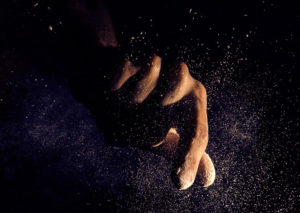 He stooped down and used his finger to write something into the dirt.
He stooped down and used his finger to write something into the dirt.
“Doesn’t this man have eyes and ears?” “Doesn’t he understand the violation?” The accusers mocked and persisted, pointing their own fingers wildly. The noise around this huddle grew louder. Only one finger was writing. Then, remaining silent, Jesus stooped down a second time into the dust beneath them and wrote again. (What did he write? Could they all see it? Why a second time? In the angry heat, how could dusty marks be any tactic?) Whatever he wrote there is not explained, but what is clear remains. What he did in the dirt was enough to silence them all. One by one, the angry men put down their stones and walked away.
What strikes me is the symmetry in both these singular stories. When Jesus writes he is likely referencing the writing of God. The fact that he does it twice, and quietly is poignant. The law God wrote was left intact that day. But now one, with her feet still there in the dust, saw the final mediator. Failure had constrained them all to face Him who alone had authority to bridge the gap between a history of shattered lawbreakers, and the Law giver Himself. He could only do that if He had fingers, eyes, ears, a knowledge of his people’s mandate intersected with a heart of compassion.
what in the world is sure
There is a growing disconnect between what’s on the news (alarming, irritating and mind-numbing) and what is on my heart. Like a miracle tonic is the soul-rest I take in from little sure things now: like sunlight, and birdsong, like seeds sprouting and yeast working. And sure things are not all sweet. The words of the prophets give me warning and set me straight when all else is failing. There is, I am experiencing, a better place of peace than the typical two options we are seeing displayed otherwise, and everywhere. You see either:
- Angry-at-this-world revolution, whether left or right, there’s a lot of this.
- Removal in self-placating denial, or just plain helplessness.
I am observing it all, pondering. My anger has gotten me nowhere (the advantage of years can teach) and helplessness is just a black hole of another name. Denial is a drug that doesn’t work. I am having to look in earnest at a different option. You can too.
Start here: Psalm 19.
The Psalms are each an emotional journaling of a God-seeker. They are honest, some are angry, none are the words of pretenders. In this one, the writer is himself looking out at what is sure. He has to look beyond himself to do that. Like a standing rider in a fast moving train, he has to grab the hand pull.
The writer speaks of the outpouring that is continually available, day and night, there for the reaching.
Then in the second section of this poetic expression, he elaborates on the source of this outpouring and what God’s provision can do in the soul. This is sure for any who will take it in. This is available now. This is pouring into our world at the same time that the other junk we have to deal with is all around us. You still have a choice.
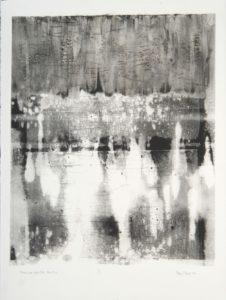 I illustrate this today with a piece I made some years ago. If you wanted to own this you would have to pay me a lot of money, and the work would need to be hand delivered for it is encaustic wax. But you can see and ponder it here for free. It is a response to Psalm 19’s declaration of the outpouring into our ground. I think it is a masterpiece, “after the Master” who said he was doing this communication into our broken places freely “day to day” and “night to night” Such an idea calms my anger, and awakens my dulled spirit. That’s what the truth does, it breaks in. George Orwell observed in another difficult time that “During times of universal deceit, telling the truth becomes a revolutionary act.” And so it is.
I illustrate this today with a piece I made some years ago. If you wanted to own this you would have to pay me a lot of money, and the work would need to be hand delivered for it is encaustic wax. But you can see and ponder it here for free. It is a response to Psalm 19’s declaration of the outpouring into our ground. I think it is a masterpiece, “after the Master” who said he was doing this communication into our broken places freely “day to day” and “night to night” Such an idea calms my anger, and awakens my dulled spirit. That’s what the truth does, it breaks in. George Orwell observed in another difficult time that “During times of universal deceit, telling the truth becomes a revolutionary act.” And so it is.
whirlwind apprehension
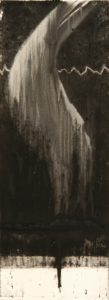 This is an older image, but a concept I’ve been revisiting in my head: the coming of whirlwind.
This is an older image, but a concept I’ve been revisiting in my head: the coming of whirlwind.
I made this monotype (ink on paper) in 2005 and titled it “Not in the Whirlwind”.
‘Sowing to the wind, reaping in return a whirlwind’ is an ancient idea and one that I’m sensing now is immediately pertinent to our current moment nationally and even globally. Hosea, a prophet to Israel in the 8th century BC, coined this visual alarm. In his writing, he spoke a mixture of severe warnings mixed with surprising hope. His listeners barely could grasp the import, and so his life became a visual aid at several points. Still, he feared their deafness to his words, saying, “My people are destroyed for lack of knowledge.” He labored to inform them. The small book we have from his pen is 14 chapters long. In the 8th chapter, he announces the coming despair, saying, “they sow the wind, and they reap the whirlwind.” He could see it in their future. His words are not angry or manipulative finger pointing but rather a lamenting plea. For what it cost Hosea to log that lament, I wonder if anyone heard? History indicates “no”, at least for the nation as a whole.
When Elijah, another even earlier prophet, retreated exhausted and discouraged, he needed God’s intervention. His story gives examples of how God moved in Elijah’s life to sustain him and then to speak to him. God was not in the whirlwind, (where I got my title for the above image). Then God was not in the earthquake, nor in the fire. But God spoke as Elijah sought Him in the coming of a gentle blowing after these events. Thus exhibited the character of God’s voice: a gentle blowing. But Elijah had to listen for it—past the din of the alarms that preceded God’s words. This is the purpose of prophecy: not to frighten but to alert any one, even just one who will listen. Prophetic words are wake-up calls.
But then as now, they are easily dismissed. When the whirlwind comes the quiet voice will be much harder heard.
what goes up
I throw my thoughts up in the air. I do this regularly now, like a seed sower.
I’m either a fool, or a confident investor. Fools say there is no god. Confidence comes from knowing: knowing that He listens, that He adjusts, that He does answer in some kind of time. I do this because things are falling apart, “the best lack all conviction, while the worst are full of passionate intensity” as W.B. Yeats said in his poem The Second Coming. That was so last century. It was rough then when he penned this. I do sense it is soon to be worse now. Thomas Cahill writes that artists see ahead so often, better than others somehow. I believe that may be true, though we are all so fallible. Mark Rothko feared that “one day the dark will swallow the red”. I am not afraid. Maybe it is because I know who is really at work.
It’s said that prayer is mystery, and surely that be true. But this I know, I’m moved to do it, so this is what I do.
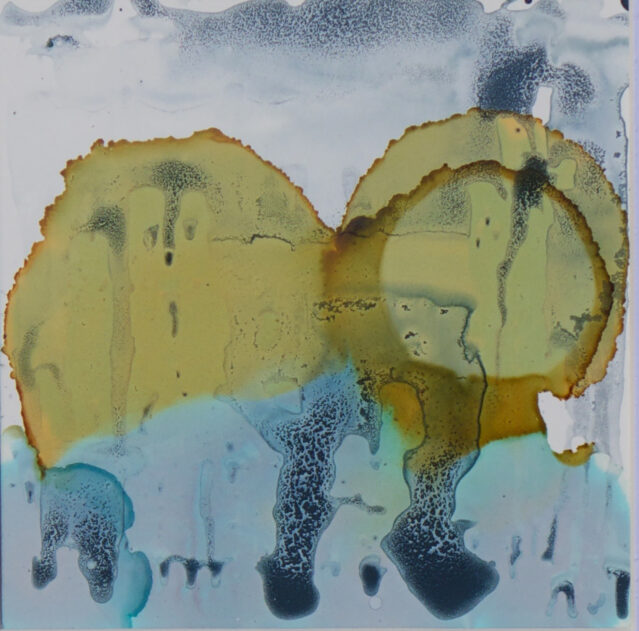
that time
If you look around in galleries or online at 21st century visual work, you will find a lot of chaos and disassembling, a lot of broken line and seeming randomness. Some of it is strikingly beautiful. And this work is concurrent with some very interesting science called chaos theory which is seeking to understand any patterns in very complex, sensitive and interdependent systems. My small piece here is one example, done with watercolor, ink and gravity. I have paired it with a Dickinson poem, #217:
“Savior! I’ve no one else to tell—
And so I trouble thee.
I am the one forgot thee so—
Dost thou remember me?
Nor, for myself, I came so far—
That were the little load—
I brought thee the imperial Heart
I had not strength to hold—
The Heart I carried in my own—
Til mine too heavy grew—
Yet—strangest—heavier since it went—
Is it too large for you?
Last night on Skype, one of my daughters and I continued our own simple investigation into the ancient words in the Psalms. We are doing this because we both need it. We are like sheep who need to be laid down and fed. It is so noisy “out there”, so many lies, so many distractions in the seeming randomness, and each of us is vulnerable. If you think you are not vulnerable, you are already dumbed into captivity. We are like the girl in the prayer meeting who ran to answer the interruption at the door. When the answer to their prayers was standing right at the gate, she could not open though she recognized his voice. She ran and told the others, and they, having just mumbled more prayers for Peter’s release, could not imagine that God was really listening, let alone had already answered. This was a group of early Jesus-followers, not much different than us. They all ended up being amazed in spite of their paltry belief.
“We are in a time.” I keep saying that to myself: we are in a time that is momentous and consequential. There is now a collision of world-views going on about which the nations’ leaders are ignorant. The lessons of history are being ignored, the warnings of Jesus have long been disregarded. The arrogance of the narrative spinners has deceived them. And the church? They are mumbling prayers, staying cloistered, and discounting any young one who comes with joy. “You are out of your mind!” the prayer group told the girl who had heard the desire of their prayers with her own ears.
After the resurrection Jesus was gentle but very direct with one of His followers who was struggling. In the face of incontrovertible evidence, Jesus still needed to say to that man “ be not unbelieving, but believing.” There is something about the will then, something about a willingness to step forward into safety with Him. “He’s still in it with us”, says Adrian Plass. And be sure you understand that there is an eternal difference between believing any other creed than the one that is only Jesus.
“A man can’t always be defending the truth; there must be a time to feed on it.” C.S. Lewis said that from hard won experience. Now is that time.
No Prisoner Be
“No Prisoner be—
Where Liberty—
Himself—abide with Thee”
Emily Dickinson,#720, 1863
My husband and I have a very dear friend who is a Prince of a man: gentle, wise and selfless are just the starting points describing the deep character of this man. My husband taught with him overseas, and labored with this man on the board of our church. Our son and daughter were both treated under his watch-care as an orthopedic surgeon.
Our friend sits right now in Federal prison, having been framed by arrogant and over zealous young prosecutors in a quick show trail. They made much noise to nab a professional over some scam that a group of people tried to pull to gain fraudulent disability payments. The evidence of our friend’s innocence was not even allowed, was apparently not even looked at in appeal. This is the crime.
What used to be called the Justice system is now a mockery to us, from first hand experience. If our friend, maybe the most blameless man we know, could be framed, then none of us are safe here and now, even in innocence.
And this man? Though he once worked as a celebrated leader serving any comers in a clinic for the poor, he now works as a tailor, using a sewing machine to mend prison garb. And he labors to mend hearts there too. He is teaching a small group the words of the great prophet Isaiah; he is mentoring a growing group of Christian leaders in their midst, modeling forgiveness and enduring faith; and, our friend is learning Greek so he can better read the original language of the New Testament.
He is not a prisoner, he is a saint; I made this for him.
in honor
 There is an image I cannot now get out of my head. You may have seen it. I wont attach the visual. Instead I leave a frame to honor the little boy whose body washed up on a beach in Turkey. My heart aches for him, for them, for us. Refugees are flooding away from the terror in the Middle East. A truck stuffed with 71 suffocated souls was left on the side of the road in Austria. Traffickers entice the desperate into what becomes more desperation. Is this not increasing horror? How do we manage this, how does my own heart respond? To ignore it is easier but I cannot. To post something about beauty, or about hope now is excruciating. I used to wonder how people handled terrible events during WW2. Now I feel I am living it.
There is an image I cannot now get out of my head. You may have seen it. I wont attach the visual. Instead I leave a frame to honor the little boy whose body washed up on a beach in Turkey. My heart aches for him, for them, for us. Refugees are flooding away from the terror in the Middle East. A truck stuffed with 71 suffocated souls was left on the side of the road in Austria. Traffickers entice the desperate into what becomes more desperation. Is this not increasing horror? How do we manage this, how does my own heart respond? To ignore it is easier but I cannot. To post something about beauty, or about hope now is excruciating. I used to wonder how people handled terrible events during WW2. Now I feel I am living it.
Evil is not explainable to the skeptic; the materialist can’t accommodate this as reality, he has to deny it. Or he chooses to shame those who don’t follow his idea of rules. It seems now that all rules are moot. All are mute.
It is noticeable to me that when confronted with such horror, a natural response is to push any idea of God away in disgust. We judge Him according to our notion of good (and where did that come from?) while we will not accommodate any notion of evil. As judge of God then, and name-caller of God followers, the mocker now feels safe. You see the put-downs and the bullying on social media. This is how we hide, anesthetizing ourselves from owning what is happening around us and within us.
But to face it full on is painful! And it seems to me that those of us who still hold conviction that God sees, that He cares have greater pain reconciling such horror in real time. If you actually believe that there is a God who exists and who cares, then where is He? His silence now is extremely troubling. If you do not hold to a God, then what difference does any of this make: none. It all means nothing. I believe we should be troubled.
The prophets saw, and wept. Jeremiah said “wilt Thou indeed be to me like a deceptive stream with water that is unreliable?” (15:18b)
Habakkuk blurted “How long O Lord, will I call for help And Thou wilt not hear, I cry out tho Thee ‘Violence’ Yet Thou dost not save.” (1:2)
Daniel: “So, I gave my attention to the Lord God to seek Him by prayer and supplications with fasting, sackcloth and ashes. . .” (9:3)
Here is some summary of what these men learned.
Do not mistake God’s seeming silence as tolerance. He sees. He is at work. And He gave answer to each prophet’s cry.
Do not mistake a terrible length of time as a sign of His impotence. He has verbalized a specific plan. He is coming back to judge. And the time lag that remains is more a sign of mercy for you to look up before it is too late.
Would you have the courage to take your own blurting questions not to others but to Him?
“And there is Hope, because of Him.
So sure and steadfast, on which my heart lays hold,
On high He hears, He’ll come from hiding
And heal the bruise that He foretold.”
“O Come great Captain, Captain of my soul
Re-create Creator, cleanse and make me whole.
The curse Commander, is a Covenant keeper!
In your care I rest, Captain of my soul.”
“And in upheavals of unbelief
that You will usher, while so urgent to reach.
Unrighteous came we, and would remain
Apart from You underneath, My God who came.”
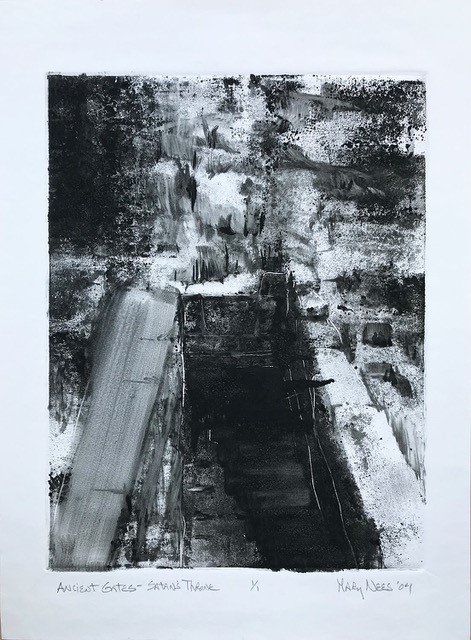
darkness is a sign
Signs in daily life are indicators. I see a red stop sign; I stop within a few feet. Signs give warning as to what’s ahead, and signs give one time to think and still to choose which way to respond. There’s a little bit of time between seeing the sign and getting my foot soundly on the brake. I am glad for that. So are my riders.
Darkness is a sign; a shaded marker that is showing up everywhere now. Look around, listen, watch. I am just articulating what you already know (maybe don’t want to know, but sense just the same). Darkness is a departure from light. It surrounds, entraps and leaves one cold. You don’t want to be there. There is nothing calming in a place of unarticulated blackness.
 Artists work in the arena of making some kind of signs, knowingly or not, coherent or otherwise. All artists are doing representation of some sort, making indicators of something else. For example, even in the arranging of darks and lights, an artist seeks to use these elements toward highlighting some aim. We even talk about “value structure” though we might otherwise insist there is not such a thing as real value indicated at all by our arrangements. Still, handling lights and darks well are basic coins of the realm in visual work. All light in the composition and we are overwhelmed and cannot see. All darkness and there simply is nothing to see. This is basic, and objectively understood.
Artists work in the arena of making some kind of signs, knowingly or not, coherent or otherwise. All artists are doing representation of some sort, making indicators of something else. For example, even in the arranging of darks and lights, an artist seeks to use these elements toward highlighting some aim. We even talk about “value structure” though we might otherwise insist there is not such a thing as real value indicated at all by our arrangements. Still, handling lights and darks well are basic coins of the realm in visual work. All light in the composition and we are overwhelmed and cannot see. All darkness and there simply is nothing to see. This is basic, and objectively understood.
Handling light and darks well in life is another matter all together. I have worked with both. I am also a current events watcher, a Bible reader, and a concerned friend. I’m noting that dark signs are stacking up faster than I have ever seen in my 4 plus decades of following the words of the prophets. There is some heaviness in all this observing, there is also some significant hope. Think about this (recorded by the first prophet Moses): the Creator came first in the Genesis account. He was primal. He was deliberative. He spoke and then light came into a place that was full of darkness. That place is further described in Genesis, 1st chapter, verse 2, as being a deep and formless void. The light entering there was a jail break, a remake. The light came into the darkness and then started staging a re-creation. And that was just in the beginning.
But there’s a problem, revealed in the story of the rest of the book. There is an imitator of light who lies, and we are all vulnerable to him. He was named by Jesus as “the father of lies”, “the serpent of old”. He entrapped the whole human race early, not long after that re-make. He masquerades as light (or as any number of fascinating imitations). He can only imitate; he cannot Create but he is crafty. Even the most earnest seekers of good get sidetracked by his clever luring. He is luring you if you are unawares. His intentions are the opposite of the Creator’s; the imitator’s intentions are not good. Like the pilgrim in Bunyan’s tale, we are too easily blinded by this one who lies.
“This life’s dim windows of the soul
Distorts the heavens from pole to pole
And leads you to believe a lie
When you see with, not through, the eye.”
And here’s a watchword: it doesn’t have to end this way. Inserted here is a video that might help you see more of the grand story. If God is the originator of the story, then there is a story, and it has a valuable end. (If He is not, then ultimately there is no story.)
poem above by William Blake, 1757-1827
image “Ancient Gates/Satan’s Throne”, monotype by Mary Nees